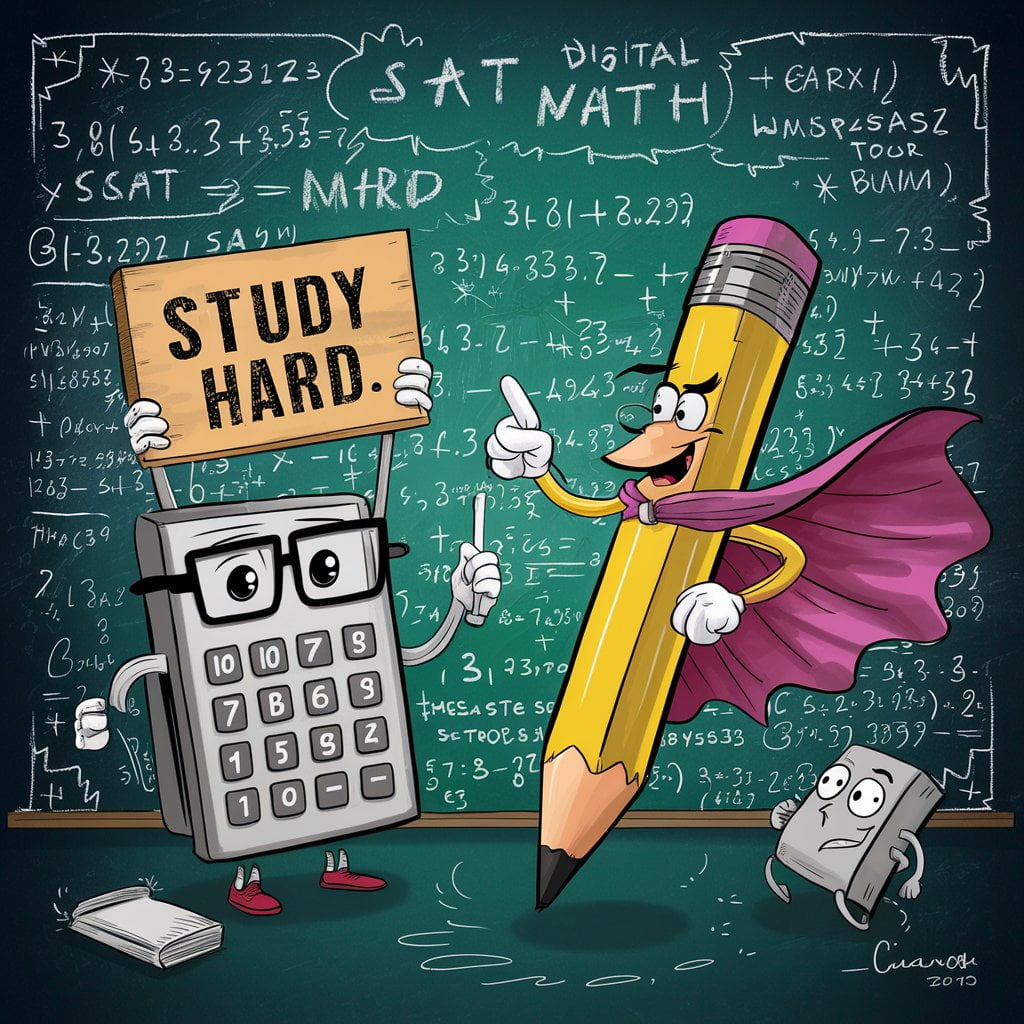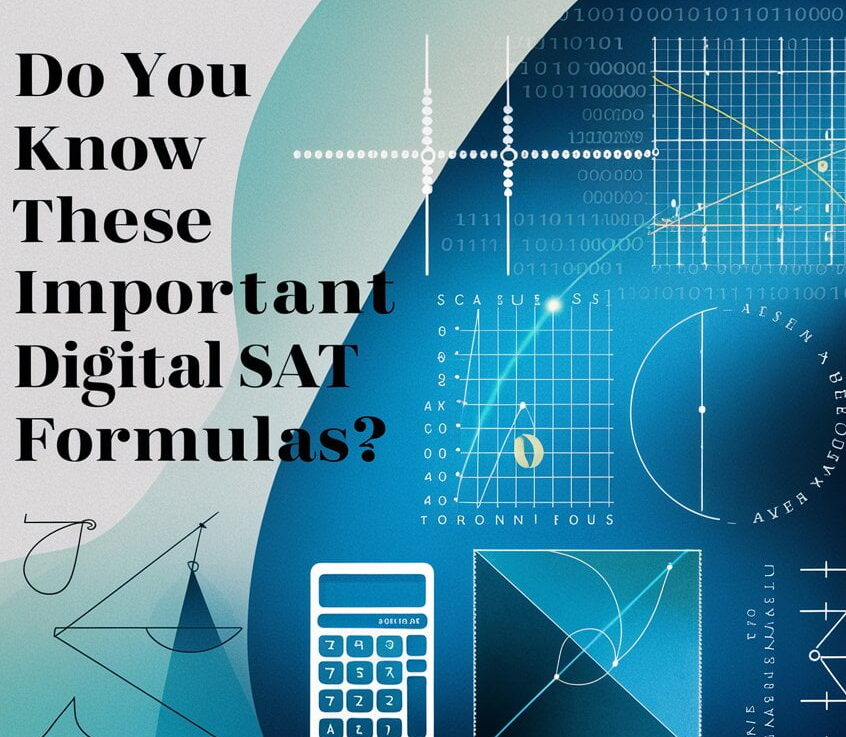Introduction
When preparing for the Digital SAT Math, one of the most effective ways to boost your performance is by mastering key formulas. While it might seem like a small part of your overall preparation, knowing these formulas inside and out can make a significant difference in your test results.
The Role of Formulas in the Digital SAT
Formulas are the building blocks of many math problems on the New Digital SAT Format . Whether you’re working on algebraic equations, geometric problems, or data analysis, formulas provide the essential framework for solving these questions efficiently. By memorizing and understanding these formulas, you’ll be able to apply them quickly and accurately, reducing the time you spend on each problem and minimizing errors.
Why Memorization is Key
In a timed test like the Digital SAT, speed and accuracy are crucial. Relying on memory to recall formulas during the exam can save precious seconds that might otherwise be spent trying to derive them from scratch. This is particularly important in a test where every second counts and where questions are designed to challenge not only your problem-solving skills but also your ability to work quickly.
Formulas vs. Understanding Concepts
While understanding the underlying concepts is important, having a set of formulas memorized ensures that you can efficiently tackle a variety of problems. For example, knowing the quadratic formula, the area of geometric shapes, and key trigonometric identities allows you to approach problems with a clear strategy and solve them more quickly. This combination of conceptual understanding and formulaic recall is essential for achieving a high score.
How to Use Formulas Effectively
Effective use of formulas involves more than just memorization. It’s important to practice applying them in different contexts and to understand how they relate to the types of questions you’ll encounter. Regular practice with problems that require these formulas helps reinforce your ability to use them correctly and efficiently during the test.
Digital SAT Math Challenges
The Digital SAT math section presents a unique set of challenges that differ from traditional pen-and-paper tests. Understanding these challenges and how to tackle them can make a significant difference in your performance.
1. Adaptive Testing and Its Impact
One of the most significant differences in the Digital SAT is its adaptive nature. The test adjusts the difficulty of questions based on your performance. This means that if you answer questions correctly, you’ll encounter more challenging problems. Conversely, incorrect answers will lead to slightly easier questions. This adaptive testing in Digital SAT requires you to perform well consistently throughout the test, as each question’s difficulty level can impact your overall score.
2. The Digital Interface
Unlike traditional tests, the Digital SAT is administered on a computer, which can be both an advantage and a challenge. Familiarizing yourself with the digital interface is crucial. For instance, using the on-screen calculator effectively and understanding how to navigate between questions can help you manage your time better. Practice tests on the same platform as the actual SAT can help you get comfortable with the interface.
3. Problem Complexity and Question Types
The Digital SAT math section includes a variety of question types, such as multiple-choice and grid-in responses. The complexity of these questions can vary, with some requiring a deeper understanding of mathematical concepts and others demanding quick mental calculations. Being prepared for both types of questions and knowing how to approach each one is essential for success.
4. Integration of Concepts
Questions on the Digital SAT often integrate multiple mathematical concepts. For example, a single problem might require knowledge of algebra, geometry, and data analysis. This integration means that you need to be comfortable with applying formulas and concepts across different contexts. Practice problems that combine different topics can help you become adept at handling these integrated questions.
5. Time Management in an Adaptive Test
Managing your time effectively is critical in an adaptive test. The ability to quickly assess and solve problems while maintaining accuracy can impact your overall score. It’s important to practice under timed conditions to develop a sense of pacing. Efficient time management allows you to answer more questions and avoid spending too long on any single problem.
6. Familiarizing with Test Content and Format
Knowing what types of questions to expect and understanding the format of the test can help reduce anxiety and improve your performance. Regularly reviewing sample questions and practice tests can provide insight into the types of problems you’ll encounter and how they are presented.
Mastering Mental Math
Sometimes small calculations can be done quickly using mental maths compared to the calculator and becomes a life long companion which is most important for casual calculations as well hence mastering mental math skills becomes crucial for efficiently solving problems and managing your time.
1. Strengthening Basic Arithmetic Skills
Basic arithmetic is the foundation of mental math. Being able to perform operations such as addition, subtraction, multiplication, and division quickly and accurately without a calculator is essential. Regular practice with mental arithmetic exercises can help you become faster and more confident in handling these basic operations.
2. Mastering Multiplication and Division Tables
Quick recall of multiplication and division tables is incredibly useful. Knowing your multiplication tables up to 12×12 and being comfortable with dividing numbers by single-digit divisors can save you time during the test. Practice these tables regularly to ensure you can recall them effortlessly.
3. Using Mental Shortcuts and Estimation
Mental shortcuts and estimation techniques can simplify complex calculations. For instance, rounding numbers to the nearest ten or hundred can make mental calculations quicker and easier. Techniques like estimating the result of a multiplication or division problem can help you narrow down answer choices and make informed decisions without performing exact calculations.
4. Practicing Mental Math Exercises
Incorporate mental math exercises into your daily study routine. Set aside time to practice problems that require you to perform calculations in your head. You can use apps, online tools, or traditional math problems to build and test your mental math skills. The more you practice, the more natural mental calculations will become.
5. Applying Mental Math Strategies During the Test
During the test, apply mental math strategies to speed up your problem-solving process. For example, break down complex problems into simpler parts, or use estimation to quickly evaluate answer choices. These strategies can help you work more efficiently and avoid getting bogged down by lengthy calculations.
6. Developing a Math Mindset
Developing a positive mindset towards mental math can also enhance your performance. Approach mental math challenges with confidence and view them as opportunities to showcase your skills. A positive attitude can help reduce test anxiety and improve your overall performance.

The Importance of Understanding Question Intent
On the Digital SAT, understanding what a question is truly asking is just as important as knowing how to apply the correct formulas. Recognizing the intent behind each question helps you approach it more effectively and select the right strategy for solving it.
1. Decoding Question Wording
SAT questions are often phrased in ways that test your comprehension as much as your mathematical ability. Carefully read each question to determine what it is asking. Look for keywords and phrases that indicate what operations or concepts are required. For instance, terms like “evaluate,” “solve,” “simplify,” or “calculate” provide clues about the appropriate approach.
2. Identifying the Key Information
Focus on identifying and extracting key information from the question and any accompanying data, such as graphs, charts, or tables. Often, questions include extraneous details designed to test your ability to sift through information and focus on what’s relevant. Highlight or note down the essential data points needed to solve the problem.
3. Recognizing Common Traps and Misleading Information
The SAT often includes answer choices that are designed to mislead or distract you. Be cautious of answers that seem correct at first glance but don’t fully satisfy the question. It’s important to double-check your work and ensure that the answer you select aligns with the exact requirements of the question.
4. Understanding What is Being Tested
Each question on the SAT is designed to test specific skills or concepts. Understanding whether a question is assessing your knowledge of algebra, geometry, or data analysis helps you apply the right method. Review common question types and practice recognizing which concepts they test.
5. Developing Problem-Solving Strategies
Develop strategies for different types of questions. For example, when faced with a word problem, translate it into a mathematical expression or equation. For questions involving graphs or charts, carefully analyze the visual data to determine what calculations are needed. Practice these strategies to become more proficient at deciphering question intent.
6. Practicing with Sample Questions
Regularly practice with sample SAT questions to become more familiar with question formats and common phrasing. This practice will help you develop an intuition for understanding what each question is asking and how best to approach it.
Strategies Beyond Formulas
While knowing key formulas is vital for tackling the Digital SAT math section, efficient problem-solving goes beyond just memorizing these formulas. It involves applying them strategically and understanding how to approach different types of problems.
1. Recognizing Patterns and Applying Logical Reasoning
One of the most effective problem-solving strategies is recognizing patterns within questions. Many SAT math problems are designed to test your ability to identify and apply patterns, whether they involve algebraic manipulations, geometric properties, or statistical relationships. Developing the ability to spot these patterns quickly can help you apply the correct formula more effectively and solve problems faster.
2. Breaking Down Complex Problems
When faced with complex problems, breaking them down into smaller, more manageable parts can be incredibly helpful. This approach involves simplifying the problem step-by-step, which often makes it easier to see which formulas or methods are applicable. For instance, if a problem involves multiple steps or combines different concepts, start by tackling each part separately before combining your results.
3. Using Estimation Techniques
Estimation can be a powerful tool, especially for questions where exact calculations might be time-consuming. By approximating answers, you can often eliminate incorrect answer choices more quickly, helping you narrow down your options. This technique is particularly useful in the calculator-allowed section, where quick estimations can guide you toward the correct answer without getting bogged down in lengthy calculations.
4. Applying the Process of Elimination
For multiple-choice questions, the process of elimination can be a valuable strategy. By systematically ruling out incorrect answer choices, you increase your chances of selecting the right answer even if you’re unsure about the solution. This method involves evaluating each option and using your knowledge of formulas and problem-solving techniques to identify which answers are unlikely to be correct.
5. Leveraging Practice Tests to Hone Skills
Using practice tests is essential for honing your problem-solving skills. They provide a realistic simulation of test conditions and help you practice applying formulas in various contexts. Analyzing your performance on practice tests can reveal areas where you might need to adjust your approach or improve your speed. There are many online resources for Digital SAT Practice test so you can regularly review and practice with these tests which can significantly enhance your problem-solving abilities.
To aid in your preparation, we’ve compiled a comprehensive PDF of essential formulas that you’ll need for the Digital SAT math section. Download the PDF to ensure you have all the key formulas at your fingertips and to help reinforce your problem-solving strategies.
Conclusion
Mastering key formulas is an integral part of preparing for the Digital SAT math section, but it’s only one aspect of a comprehensive strategy. Understanding the role of formulas, developing mental math skills, and navigating the unique challenges of the Digital SAT can significantly impact your performance. As you prepare, remember that effective problem-solving extends beyond memorizing formulas—it involves recognizing question intent, avoiding common pitfalls, and applying strategic approaches to various problem types.
By integrating these strategies into your study routine and practicing regularly, you’ll be better equipped to handle the diverse range of questions on the test. Consistent practice with both formulas and problem-solving techniques will not only boost your confidence but also enhance your efficiency during the exam.
To support your preparation further, we’ve provided a downloadable PDF of essential Digital SAT formulas. This resource will serve as a valuable tool for reviewing and memorizing the formulas you’ll need on test day. With thorough preparation and a strategic approach, you’ll be well-positioned to achieve a strong score in the math section of the Digital SAT.
Good luck with your preparation, and remember that every bit of effort you invest now will pay off on test day.
Frequently Asked Questions (FAQs) :
Q. Does the Digital SAT have a formula sheet?
Yes, the Digital SAT includes a formula sheet as a valuable resource for the Math section. This reference guide provides a collection of essential mathematical formulas to support you during the test. While it’s a helpful tool, it’s crucial to remember that the SAT often emphasizes problem-solving abilities rather than simple formula recall. Therefore, understanding the concepts behind the formulas is just as important as knowing the formulas themselves.
Q. What formulas are given on the Digital SAT?
The formula sheet provided on the Digital SAT primarily focuses on geometry formulas. Here’s a general overview of the types of formulas you can expect to find:
- Area and circumference of circles
- Area of triangles, rectangles, and other polygons
- Pythagorean theorem
- Volume of prisms, cylinders, cones, pyramids, and spheres
- Angle relationships in circles and triangles
Important note: While the formula sheet provides a helpful resource, it’s crucial to understand the concepts behind the formulas and be able to apply them effectively. The SAT often tests your ability to think critically and solve problems, even if the formula is provided.



